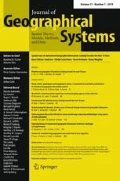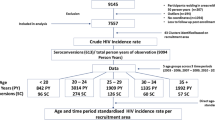Abstract
The ability to establish spatial links between gonorrhea risk and demographic features is an important step in disease awareness and more effective prevention techniques. Past spatial analyses focused on local variations in risk, but not on spatial variations in associations with demographics. We collected data from the Baltimore City Health Department from 2002 to 2005 and evaluated demographic features known to be associated with gonorrhea risk in Baltimore, by allowing spatial variation in associations using Poisson geographically weighted regression (PGWR). The PGWR maps revealed variations in local relationships between race, education, and poverty with gonorrhea risk which were not captured previously. We determined that the PGWR model provided a significantly better fit to the data and yields a more nuanced interpretation of “core areas” of risk. The PGWR model’s quantification of spatial variation in associations between disease risk and demographic features provides local and demographic structure to core areas of higher risk.




Similar content being viewed by others
References
Alves ATJ, Nobre FF, Waller LA (2016) Exploring spatial patterns in the associations between local AIDS incidence and socioeconomic and demographic variables in the state of Rio de Janeiro, Brazil. Spat Spatio Temp Epidemiol 17:85–93
Anselin L, Syabri I, Kho Y (2006) GeoDa: an introduction to spatial data analysis. Geogr Anal 38(1):5–22
Becker K, Glass G, Brathwaite W, Zenilman J (1998) Geographic epidemiology of gonorrhea in Baltimore, Maryland, using a geographic information system. Am J Epidemiol 147(7):709–716
Bernstein KT, Curriero FC, Jennings JM, Olthoff G, Erbelding EJ, Zenilman J (2004) Defining core gonorrhea transmission utilizing spatial data. Am J Epidemiol 160(1):51–58
Bush KR, Henderson EA, Dunn J, Read RR, Singh A (2008) Mapping the core: chlamydia and gonorrhea infections in Calgary, Alberta. Sex Transm Dis 35(3):291–297
De Waroux O, Harris RJ, Hughes G, Crook PD (2014) The epidemiology of gonorrhea in London: a Bayesian spatial modeling approach. Epidemiol Infect 142:211–220
Decennial census of population and housing. http://www.census.gov. Accessed 8 Aug 2017
Delmelle E, Hagenlocher M, Kienberger S, Casas I (2016) A spatial model of socioeconomic and environmental determinants of dengue fever in Cali, Colombia. Acta Trop 164:169–176
ESRI Inc. ESRI v10 (2015) ArcGIS. ArcInfo version. Redlands, CA
Fotheringham A, Brunsdon C, Charlton M (2002) Geographically weighted regression: the analysis of spatially varying relationships. Wiley, New York
Gesink DC, Bernstein KT, Serre ML, Schumacher CM, Leone PA, Zenilman JM, Miller WC, Rompalo AM (2006) Modeling a syphilis outbreak through space and time using Bayesian maximum entropy approach. Ann Epidemiol 16:797–804
Gesink D, Wang S, Norwood T, Sullivan A, Al-Bargash D, Shahin R (2014) Spatial epidemiology of the syphilis epidemic in Toronto, Canada. Sex Transm Dis 41(11):637–648
Gindi RM, Sifakis F, Sherman SG, Towe VL, Flynn C, Zenilman JM (2011) The geography of heterosexual partnerships in Baltimore City adults. Sex Transm Dis 38(4):260–266
Gonorrhea—CDC Fact Sheet. http://www.cdc.gov/std/gonorrhea/stdfact-gonorrhea.htm. Updated October 4th, 2017. Accessed 15 Nov 2018
Gonorrhea treatment and care. https://www.cdc.gov/std/gonorrhea/treatment.htm. Updated October 31st, 2017. Accessed 15 Nov 2018
Hurvich C, Tsai C (1989) Regression and time series model selection in small samples. Biometrika 76:297–307
Jacquez GM, Greiling DA (2003) Local clustering in breast, lung and colorectal cancer in Long Island, New York. Int J Health Geogr 2:3
Jennings JM, Curriero F, Celentano D, Ellen JM (2005) Geographic identification of high gonorrhea transmission areas in Baltimore, Maryland. Am J Epidemiol 161(1):73–80
Jennings JM, Taylor RB, Salhi RA, Furr-Holden CD, Ellen JM (2012) Neighborhood drug markets: a risk environment for bacterial sexually transmitted infections among urban youth. Soc Sci Med 74(8):1240–1250
Kulldorff M (2009) SaTScan v 8.0: SOFTWARE for the spatial and space-time scan statistics. National Cancer Institute, Bethesda
Loader C (1999) Local regression and likelihood. Springer, New York
McCullagh P, Nelder J (1989) Generalized linear models. Chapman & Hall, London
Nakaya T, Fotheringham A, Brunsdon C, Charlton M (2005) Geographically weighted Poisson regression for disease association mapping. Stat Med 24:2695–2717
Owusu C, Baker KM, Paul R, Curtis AB (2018) Modelling individual vulnerability to sexually transmitted infections to optimize intervention strategies: analysis of surveillance data from Kalamazoo County, Michigan, USA. Sex Transm Infect 94(5):353–358
R Core Development Team (2015) R: a language and environment for statistical computing, reference index version 3.2.3. R Core Development Team, Vienna
Sullivan AB, Gesink DC, Brown P, Zhou L, Kaufman JS, Fitch M, Serre ML, Miller WC (2011) Are neighborhood socioeconomic factors influencing the spatial pattern of gonorrhea in North Carolina? Ann Epidemiol 21:245–252
Tan NX, Messina JP, Yang JG, Yang B, Emch M, Chen X, Cohen MS, Tucker JD (2011) A spatial analysis of county-level variation in syphilis and gonorrhea in Guangdong Province, China. PLoS ONE 6(5):1–8
TerraSeer Inc. ClusterSeer version 2. Ann Arbor, MI
Tobin KE (2012) An examination of spatial concentrations of sex exchange and sex exchange norms among drug users in Baltimore, MD. Ann Assoc Am Geogr 102(5):1058–1066
U.S. Census Bureau. http://www.census.gov. Accessed 8 Aug 2017
Waller L, Zhu L, Gotway C, Gorman DM (2007) Quantifying geographic variations in associations between alcohol distribution and violence: a comparison of geographically weighted regression and spatially varying coefficient models. Stoch Env Res Risk Assess 21(5):573–588
Wheeler D, Waller L (2009) Comparing spatially varying coefficient models: a case study examining violent crime rates and their relationships to alcohol outlets and illegal drug arrests. J Geogr Syst 11(1):1–22
Xing J, Li YG, Tang W, Guo W, Ding Z, Ding G, Wang L, Qin Q, Xu Y, Qian S, Mahapatra T, Wang L (2014) HIV/AIDS epidemic among older adults in China during 2005–2012: results from trend and spatial analysis. Clin Infect Dis 59(2):53–60
Zhu YB, Wang QX, Liang S, Gong Y, Yang M, Chen Y, Nie S, Nan L, Yang A, Liao Q, Yang Y, Song X, Jiang Q (2015) Geographical variations in risk factors associated with HIV infection among drug users in a prefecture in Southwest China. Infect Dis Poverty 4(38):1–10
Funding
Dr. Switchenko was funded by the Biostatistics in Genetics, Immunology, and Neuroimaging (BGIN) training grant, a predoctoral training grant from the National Institute of General Medicine Science (NIGMS). Dr. Jennings was funded for this work by the National Institute of Drug Abuse (Grant Number KO1 DA022298-01A1).
Author information
Authors and Affiliations
Corresponding author
Ethics declarations
Conflict of interest
The authors declare that they have no conflicts of interest.
Additional information
Publisher's Note
Springer Nature remains neutral with regard to jurisdictional claims in published maps and institutional affiliations.
Electronic supplementary material
Below is the link to the electronic supplementary material.
10109_2020_321_MOESM1_ESM.tif
Supplemental Fig 1 Maps of observed SIR (a) and predicted SIR (b) from 2002 to 2003; maps of observed SIR (a) and predicted SIR (b) from 2004 to 2005 (TIFF 26367 kb)
Rights and permissions
About this article
Cite this article
Switchenko, J.M., Jennings, J.M. & Waller, L.A. Exploring spatially varying demographic associations with gonorrhea incidence in Baltimore, Maryland, 2002–2005. J Geogr Syst 22, 201–216 (2020). https://doi.org/10.1007/s10109-020-00321-7
Received:
Accepted:
Published:
Issue Date:
DOI: https://doi.org/10.1007/s10109-020-00321-7




